Top News
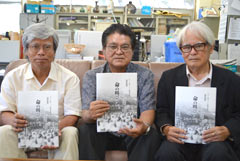
May 30, 2013 Ryukyu Shimpo
A compilation of newspaper articles, press reports and testimonies about the crash of a U.S. military aircraft onto Miyamori Elementary School in 1959 has been published. The title is, “We do not want to die, call for life, we want to forget, we do not want you to forget, we will never let it be forgotten. An aircraft crashed onto Miyamori Elementary School in Ishikawa.”
The book is made up of pictures of family members, the aircraft and the school taken immediately after the accident, as well as newspaper articles with testimony from U.S. military personnel and commentary on compensation issues. It also includes background information about the movie about the incident called Himawari and feature articles about the danger involved in the Osprey being deployed to Futenma Air Station.
The chair of the non-profit organization Life and Peace Storytellers Ishikawa Miyamori 6-30 Group, Mitsuki Toyohama, who was working at the morgue at the time of the accident, also included his personal notes and lecture scripts.
Toyohama states, “Children of people who survived the Battle of Okinawa were victims of the accident. If there was no war the U.S. military bases would not be here and the accident would not have occurred.” The testimony record is 221 pages long and sells for 1800 yen. Proceeds will be used for the construction fund of a permanent exhibition “Hall 6-30.” For inquiries and orders, call the 6-30 Group Office at 090 (8293) 8615. (“6-30” refers to June 30 when the accident occurred in 1959.)
(English translation by T&CT, Megumi Chibana and Mark Ealey)
Go to Japanese

May 30, 2013 Reiko Akamine of Ryukyu Shimpo
From the end of September, the Himeyuri Peace Museum will end its program of sending out Himeyuri Student Corps survivors, who lived through the Battle of Okinawa, as lecturers for students on school trips. Since opening in 1989, the museum located in Itoman has educated many people about the misery of war.
The survivors have given lectures for over 20 years to let people know about the harsh realities of the Battle of Okinawa. As the age of the lecturers approaches the late 80s, in consideration of their health, the museum decided to end lecture activities outside of the museum. From October, the ladies will only give lectures within the museum. Director Yoshiko Shimabukuro said, “We do have some concerns, but this is the right decision to make to ensure that we can continue the lectures as long as possible.”
Lectures outside the museum are mainly held at visiting students’ places of accommodation, and often run past 10:00 p.m. Staff and family members of the speakers, who are now aged between 84 and 88, have voiced concerns about their health and safety. After much discussions starting last year, on March 18, 2013, the end of this program was officially communicated to travel agencies and other related organizations.
The museum had 27 lecturers when it first opened, but this number has decreased to ten due to death and illness. At the same time, the frequency of speeches per person has increased.
According to the museum, the number of lecturing appointments, including talking to individuals, exceeded one thousand each year. On average, each lecturer gives almost 100 lectures annually. Some days one person may have to give as many as three lectures. Of the 615 appointments received by the office in 2012, outside lectures accounted for about half of them.
Expressing her desire to continue the museum lectures, Shimabukuro said, “Motivated by our friends who have passed on, and as our duty as survivors, we have taught people about the horrors of war. I do not know for how long we can continue doing this, but, without stressing ourselves too much, I would like to do this for a long time to come.” On the other hand, she expressed the hope of the next generation passing on the survivors’ experiences. “Students whom we have lectured to tell us that they ‘will tell everyone.’ That has encouraged us to continue. I would like the younger generations to inherit our dreams of peace.”
(English translation by T&CT, Lima Tokumori and Mark Ealey)
Go to Japanese

June 1, 2013 Ryukyu Shimpo
A capybara was spotted in the Arakawa River in Ishigaki on the evening of the May 27. Firefighters rushed to the scene after being notified by residents but they failed to capture the animal, which fled at a pace belying its appearance. The animal, which may have escaped from a tourist facility in the city, has been seen in the river since March. Saying that it will damage crops, the Ishigaki Municipal Office has called for residents to provide information to help capture the capybara.
About one meter long, the animal was standing quietly in the shallows when it was found. When a firefighter approached the capybara it suddenly leapt up and ran away. Four firefighters rushed to the scene to catch it with a net, but it had fled by the time they got there. They were unable to find it in the grass at night and eventually gave up.
The capybara is the largest rodent living in the Amazon basin. This herbivorous animal that prefers an environment involving water has likely settled in the Arakawa River after escaping from a tourist facility.
(English translation by T&CT, Mark Ealey)
Go to Japanese
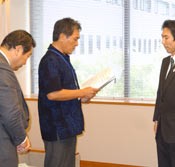
May 30, 2013 Ryukyu Shimpo
On May 29 in Tokyo, Okinawa Vice Governor Kurayoshi Takara and the members of the Okinawa Federations of Fisheries Cooperatives and the Ikema Fisheries Cooperatives asked Senior Vice Minister of Agriculture, Forestry and Fisheries, Taku Eto to review the Japan-China fisheries pact. The fishermen said the governments concluded this pact in 1997 without any explanation to the local people before it went into effect in 2000. They suggested that the agreement has led to overfishing of coral reefs and has devastated the habitat of bottom fish.
They asked for the government to review the pact by working with China at the Joint Fisheries Committee meeting to be held June. According to the vice governor, the senior vice minister suggested that the government will take the request from Okinawa into consideration. The area of water below 27 degrees north latitude is not covered by the Japan-China fisheries pact. In the letter sent by the Foreign Minister of Japan to his counterpart of China at that time, Japan agreed that it would not apply the relevant fisheries laws to Chinese fishing boats in that area of water. Okinawan fishermen asked the government to resolve three issues: (i) Rescinding the content of the Foreign Minister’s letter and regulating the Chinese fishing boats working within the area of water (ii) Creating a system to prevent net fishing on coral reefs (iii) Review the area of water included in the Japan-Taiwan fishing pact. Vice Governor Takara commented, “Overfishing of coral reefs is a serious problem that leads to the depletion of the natural resources in the waters around Okinawa. In order to protect the interests of local fishermen, we want the government to negotiate with Beijing and Taipei as an issue of political significance.”
While Deputy Chief Cabinet Secretary Kazuhiro Sugita and Vice Minister for Foreign Affairs Minoru Kiuchi commented that they would like to receive on local concerns, they did not mention reviewing the fishery pacts.
(English translation by T&CT, Mark Ealey)
Go to Japanese
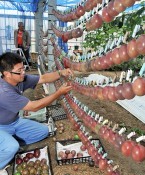
May 26, 2013 Ryukyu Shimpo
Passion fruit is now in the harvest season at the Itoman Tourist Farm in Mabuni, Itoman. Clusters of ripe fruit are waiting for shipment.
Kiyonori Oshiro, a 38-year-old contract farmer, said, “Our harvesting was delayed a little because of the typhoon last year, but we are likely to be able to ship two tons of fruit as has been the case in the past.” The harvest will continue until around August. Some will be processed into wine on the farm and the rest will be sold at the Umanchu Farmers’ Market in Itoman.
(English translation by T&CT, Mark Ealey)
Go to Japanese

Go To Video
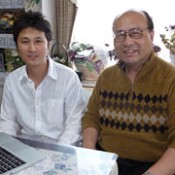
May 27, 2013 Yoko Shima of Ryukyu Shimpo
Yoshito Shimajiri, a 31-year-old astronomer whose father is from Miyako-jima City, will be hired at the National Institute of Saclay in France from June. It is rare for this institute to employ Japanese researchers. When Shimajiri came to Miyako-jima visiting family he would observe the stars with a telescope that he brought with him. “I was really glad to be able to see stars so clearly in Miyako-jima. I want to work towards finding a solution to the mystery of why stars are born,” said Shimajiri.
Born in Saitama Prefecture, where he now lives, Shimaijri studied at the Graduate School of the University of Tokyo after graduating from Sophia University. He has worked as a researcher at the Nobeyama Radio Observatory in Nagano Prefecture since 2010. The focus of his study is the origin of stars and where new stars are being born in a stellar nursery or molecular cloud.
His team observed the Orion with the huge radio telescopes of observatories in Nobeyama and in Chile. They found that gas ejected from one star has possibly produced a star formation around it. After the results of their research were reported in international academic conferences he was invited to work at the National Institute of Saclay in France.
There are few facts that the researchers know regarding the origin of stars. Shimajiri says, “Astronomy is something which even if a person dedicates all his or her life to it, not everything can be known. However, I will keep working hard on my research.” He delivered a class on astronomy at Miyajima Elementary School in Miyako-jima two years ago. “In the future I would like to work teaching
somewhere like Okinawa where there isn’t a department of astronomy in the local universities,” he said.
(English translation by T&CT, Mark Ealey)
Go to Japanese
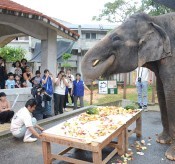
May 19, 2013 Ryukyu Shimpo
On May 19, a birthday ceremony for Indian elephant Ryuka was held at the Okinawa Zoo & Museum. She turned 13 years old on May 22. About 50 people celebrated her birthday by singing songs. Children made a birthday cake with 15 kilograms of 15 kinds of fruit and drew the number “13” with the fruit. When the children called her name, Ryuka came over and using her long trunk ate up all the cake. The children cheered as they watched her.
Junsei Tokumoto, a 10-year-old boy from Chatan, said, “So much fruit disappeared really quickly. She is so cute and ate up all that food using her trunk.”
(English translation by T&CT, Hitomi Shinzato and Mark Ealey)
Go to Japanese
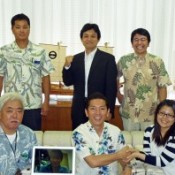
May 26, 2013 Ryoki Nagahama of the Ryukyu Shimpo
Event organizers from all around the world involved in the Startup Weekend will meet for the first time in Asia in Urasoe this autumn. According to the organizer, Startup Weekend is a global network of leaders and entrepreneurs on a mission to inspire, educate, and empower individuals, teams, and communities. The organizers hold events in many countries. Participants, including students, share ideas to become entrepreneurs for the weekend. Local members also expect the summit meeting to help create self-sustaining businesses in Okinawa through networking with members from other countries and listening to their business success stories.
Members who have organized a Startup Weekend event in their own countries will take part in the meeting, which is carried out once every six months. About 200 people from more than 40 countries participated at the last summit meeting, which took place in Rio de Janeiro, Brazil over four days in March. Since they began in the United States in 2006, Startup Weekend events have been held more than 700 times in 92 countries, including Japan. The project has produced many entrepreneurs. The events have been held twice in Okinawa and the third Startup Weekend is scheduled for July.
In the Startup Weekend Organizer summit in Okinawa, organizers will exchange opinions with Okinawan young people who have entrepreneurial aspirations. They aim to make use of the event to introduce local performing arts and cultural assets to a broader range of people. Preparation for the event is being carried out with the cooperation of the Urasoe Municipal Office.
One of the organizers, Satoru Iizuka, a 44-year-old teacher, said, “Support projects for cultivating entrepreneurs have just started in Japan. This summit represents a breakthrough.”
Mayor Tetsuji Matsumoto, who will host the organizers summit, said, “We would like to show the people of Urasoe what creating a business is all about.”
(English translation by T&CT, Mark Ealey)
Go to Japanese
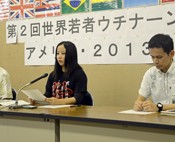
May 18, 2013 Ryukyu Shimpo
On May 16, Minami Tamamoto, the director of the Okinawa head office of the World Youth Uchinanchu Association (WYUA), and Shingi Kuniyoshi, the president of the Okinawa Association of America (OAA), held a press conference at the Okinawa Prefectural Office to provide more details about the 2nd World Youth Uchinanchu Festival. The festival will be held in Los Angeles from July 18 to 21.
They expect that youth of Okinawan descent will participate in the festival from eight countries. The event will include cultural workshops and international conferences and will feature a declaration of solidarity on the final day. According to Kuniyoshi, the North American branches of the WYUA and the OAA are considering holding fund-raising events and other programs.
Kuniyoshi said, “We would like to encourage participation from around the world and would like participants from Okinawa to broaden their perspective.” Tamamoto said, “The culture of North America is different to that of South America, where the festival was held last year. We value these differences.” She added, “Taking things one step at a time, by holding this activity annually we would like to create our own history.”
(English translation by T&CT, Lima Tokumori and Mark Ealey)
Go to Japanese
May 29, 2013 Ryukyu Shimpo
A U.S. Air Force F-15 fighter belonging to Kadena Air Base crashed in the Pacific about 115 kilometers east of Okinawa. The Okinawa Fisheries Cooperative has fish aggregating devices in the water around the so-called “Area Hotel-Hotel” airspace and waters designated as a training area, where the F-15 went down. Fishing boats were in the water around that area. The crash could have damaged them and an F-15 crash on land in Okinawa could have caused a cataclysmic disaster.
How much longer will the U.S. and Japanese governments continue to expose Okinawans to such dangers?
A F-15 from Kadena crashed in 2006. An aircraft belonging to the Naha Air Base of the Japan Air Self-Defense Force crashed in 2011. The U.S. Air Force has stationed F-15s at Kadena Air Base since 1979 with nine crashes involving ten aircraft in the 34 years since then. Calculations indicate that F-15s have gone down once every 3.7 years. Is the cause mechanical failure or human error? Either way, we assert that the F-15 poses a risk to the people of Okinawa.
Okinawa has experienced various military aircraft crashing in the past.
Besides this F-15 crash, U.S. military aircraft have gone down in Okinawa 44 times since Okinawa’s reversion to Japanese sovereignty in 1972. That means that military aircraft have crashed more than once every year.
By the end of December, 2012 a total of 540 aircraft-related accidents had occurred, killing 34 people. We do not see this as a normal situation.
On this occasion, the F-15 went down in the waters off Okinawa, causing no harm to Okinawan people. However, in the past U.S. military aircraft have crashed on Okinawa several times.
On June 30, 1959, a U.S. F-100 fighter from Kadena Air Base crashed onto Miyamori Elementary School in Ishikawa, killing 18 people including young children.
A U.S. Marine Corps CH-53D Sea Stallion heavy assault transport helicopter based at Futenma Air Station also crashed into a building at Okinawa International University. Miraculously, the accident did not injure or kill any students or local citizens.
Last October, the U.S. military deployed 12 MV-22 Osprey vertical take-off and landing transport aircraft to Futenma Air Station. The Japanese government ignored the people’s will and forced this through despite the Okinawa Governor and the heads of all the municipalities in the prefecture having opposed the deployment.
There have been seven crashes by Osprey during the period from its developmental stages to last July. When a total of 36 people have been killed in these crashes it is difficult to dispel doubts that the Osprey is flawed.
The U.S. and Japanese governments now plan to force through the deployment of another squadron of 12 Osprey to Okinawa this summer.
Rules and safety policies have been put in place by the two countries, but the U.S. military does not abide by them. Nevertheless, the U.S. and Japanese governments continue to put dangerous aircraft into the sky over Okinawa. How can they guarantee the safety of the local citizens?
We demand that the two governments indefinitely ground all military aircraft that we see as having safety issues. This includes the Osprey. Otherwise the people of Okinawa cannot live safely.
(English translation by T&CT, Mark Ealey)
Go to Japanese
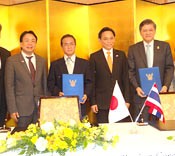
May 23, 2013 Ryukyu Shimpo
On May 22, the Prefectural Brewing Association and the Thai Rice Exporters Association entered into an agreement to promote the use of Thai rice for awamori brewing. They agreed on the safety and stable supply of Thai rice and activities to help expand the market for awamori. They will also work together to develop new projects. Thai Commerce Minister Boonsong Teriyapirom attended the signing ceremony held at the Imperial Hotel in Chiyoda-ku, Tokyo. In an interview with the Ryukyu Shimpo, he expressed his support for awamori market expansion by stating, “It’s a great pleasure to hear that Thai rice has been used for awamori brewing since the Ryukyu Kingdom era. I would like to welcome the agreement, not only for supplying Thai rice but also for expanding the market for awamori in Thailand.”
The president of Brewing Association, Masayuki Taira, said, “Thai rice allows awamori to keep its distinctive qualities of richness and mellowness. We would like to work together to develop a trusting relationship to bring benefits to both sides.” Vice president of the association Charoen Laothamatas stated, “I am very grateful that you recognize the quality of Thai rice. This official recognition by the Thai government to work collaboratively will strengthen the partnership for both sides.”
(English translation by T&CT, Megumi Chibana and Mark Ealey)
Go to Japanese











 Webcam(Kokusai Street)
Webcam(Kokusai Street)


